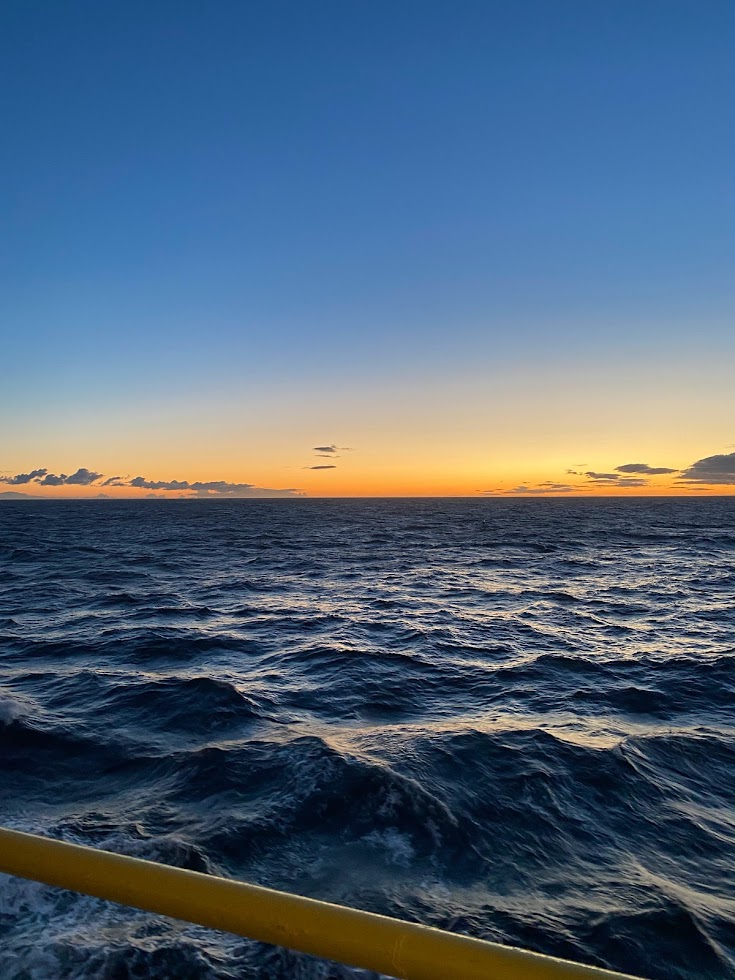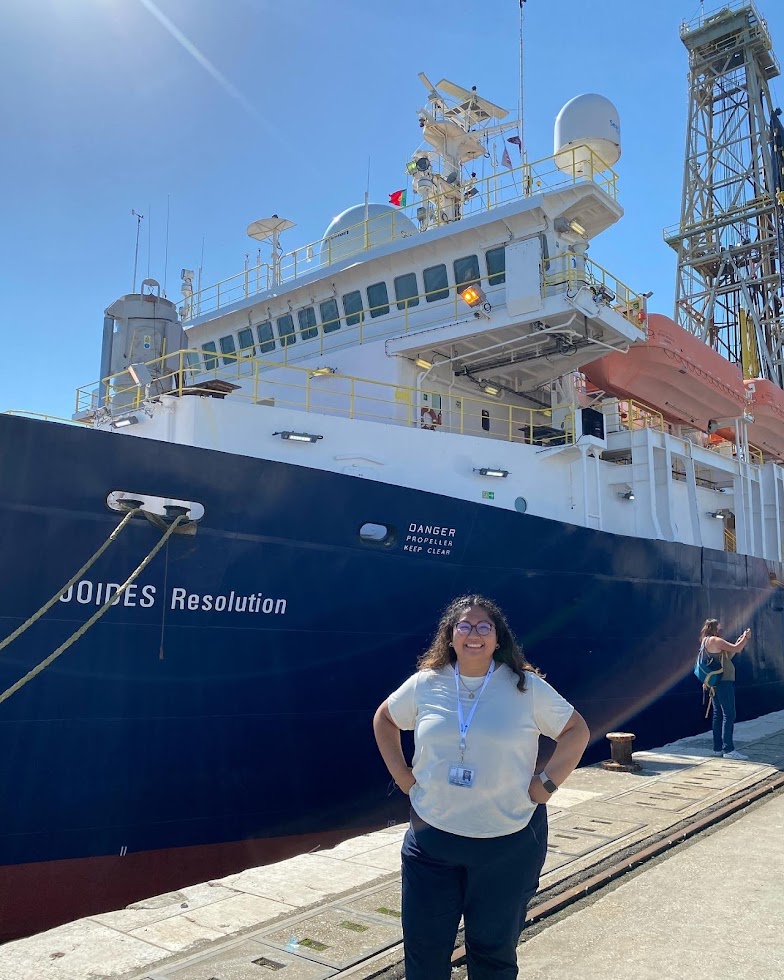Saray Sanchez, 3rd year OEAS PhD (MG&G)

From October 2022 to December 2022, I was onboard the iconic International Ocean Discovery Program (IODP) JOIDES Resolution. We were drilling into the ocean floor just off the coast of Portugal. Our goal was to recover sediment from 4 sites that held promising evidence for records of large-scale climate change. To reach our goals, the ship worked 24/7 for 8 weeks, with most people being assigned to day (noon to midnight) or night (midnight to noon) shifts. I was assigned to the night shift. Here’s what most of my days looked like.

“Morning” (10pm-12am)
My mornings began just two hours shy of midnight. I would wake up and take a short three-minute commute to the gym on board. The gym was surprisingly fully equipped with many cardio machines, free weights, and even a rock climbing finger board. Typically, the gym was rather empty at this time and I could connect my phone to the Bluetooth speaker and blast Beyonce’s Renaissance album while I strut on the treadmill.

After my workout, I would head back to my room and begin getting ready for the day. A few steps in my routine I would never miss were (1) taking my vitamin D pills to make up for the lack of sun I saw, (2) putting on my gold hoops that reminded me of my family and my culture, and (3) putting out my laundry so it was done by the time my shift was over.
Finally, with about 20 minutes left I would rush upstairs to the galley (cafeteria) and quickly eat cereal before reporting to the lab.
During Shift (12am – 12pm)
I sailed as a scientist and was assigned to be a physical properties specialist. I had many duties on board including running cores through multiple instruments, writing reports, and taking samples of the cores. However, before I could even start with any of my duties we would begin every shift with a crossover meeting with folks from the last shift. We would update each other on how many cores we had drilled, any issues that came up, and any resolutions found during the shift. After the crossover meeting, I would pick up where the day shift left off. During the majority of my shift I would be lifting core sections that were 1.5 meters long and about 15- 20 lbs and moving them on and off the rack to different instruments. Truthfully, during the first week I felt so sore that my arms would pulse in pain while trying to sleep. Towards the end of the expedition though, I was strong and lifting cores felt like second nature to me.

During shift we were always well fed. We had snack breaks every three hours which featured an array of drinks and freshly baked goods. At the six-hour mark we would have lunch and the menu was different every day. A few of my favorite dishes served included peanut butter chicken with rice, lentil dahl, and pulled pork burgers. The best part of every week was Sunday lava cakes. It reminded us that another week has passed on the ship. The lava cake was adored by all on the ship so much that there was a dedicated countdown clock for the lava cake. I really miss the lava cakes.


My favorite part of the shift had to be the short 10 minutes when many scientists would gather outside to watch the sunrise together. I saw some of the most beautiful sunrises in my life on this expedition. It was breathtaking being able to see the sunrise in the open ocean with no trees, buildings, or mountains obscuring my view. So many shades of purple, pink, blue, fiery red, and orange danced across wispy and fluffy clouds. One time I even saw the infamous “green flash” which is an optical phenomenon in which the sun changes color to green for just one moment at sunrise or sunset.



After sunrise I knew the end of my shift was close, and I would begin to write down in my daily report what happened during shift for the next crossover meeting.
After shift (12pm- 2am)
Immediately after shift I would eat dinner with the rest of the scientists and technicians from my shift. I would try to have a light dinner as I would often be trying to sleep within the next two hours, and it’s a little hard to sleep with a full stomach on a rolling ship. Sometimes a group of scientists would gather in the movie room and watch a film. The movies we would watch depended on the shift. If the shift was slow because we were waiting to drill due to weather, then we would watch a high-energy action movie. If the shift was full of constant movement and a little more tiring than usual, then we would watch a comedy or something more light-hearted.
I would often have time after my shift to call home. Luckily, all scientists were given internet access on one personal device. I chose to have my phone as my device so I could text and call my loved ones throughout the day easily.
After our shifts was when we would celebrate holidays, birthdays, and expedition milestones. We were able to celebrate both Halloween and Thanksgiving onboard with themed meals. We sang karaoke and had dance parties. I would give haircuts and paint people’s nails. We would try our hand at photography with cool 360° cameras. It was a great time to get closer to the other scientists on board and really humanized scientists for me.




Last thoughts
Overall, I really enjoyed my experience on Expedition 397. It provided a unique environment for me to interact and live with people from around the world. The scientific team was lovely, and the staff onboard were knowledgeable and inclusive. I would highly recommend any graduate student interested in deep sea drilling to apply to an IODP cruise!

Follow more of Saray’s science on Twitter at @paleosanchez and of the IODP Expedition 397 cruise under the hashtag #Exp397.

